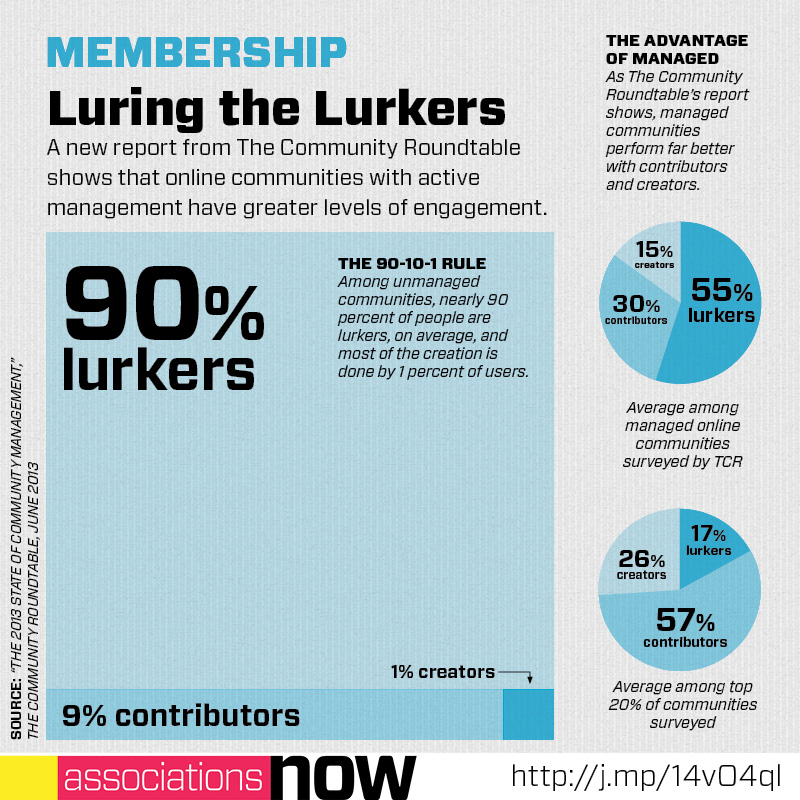
What Can a Community Manager Do For You?
A new report on community management practices shows a clear ROI for the active care and feeding of your online member community.
If your association’s online community, discussion group, or listserver seems like it’s only used by a small group of hyper-engaged members, it probably follows closely with the 90-9-1 rule. (90 percent lurkers, 9 percent contributors, 1 percent creators.) And, if you’re like me, you think 90 percent of a community’s users “lurking” and never contributing is a mountain of riches going to waste. So much knowledge, experience, and perspectives left unshared.
But what if you could get your community’s engagement profile to look something more like 55-30-15? Or even 17-57-26? It takes some time and effort, but a new study says those numbers are possible with community management done right.
A typical community manager is a mid-level professional, highly networked within their organization, with a few years of online community experience.
“The 2013 State of Community Management” report was published last week by The Community Roundtable, a community for community managers. It’s most striking finding was “quantifying just how much active community management correlates with high levels of engagement.” The average engagement ratio across all respondents, coming mostly from community managers at tech, telecom, and software companies, was 55-30-15. The ratio among the top 20 percent of respondents was 17-57-26. In that top group, that’s more content creators than lurkers—any association community manager’s dream.
So, what are these community managers doing to drive engagement? Additional findings in the survey offered detail on a lot of the emerging best practices in what is still a rather new field (the average community program in the survey was just five years old), but here are some highlights:
- The average community manager has about eight years of work experience and three to four years of experience in community management specifically. In other words, these are not interns or entry-level workers.
- “Engagement and people skills” rank highest among desired skills for community managers. Technical skills were deemed much less important.
- Content promotion and welcome emails are the two most common duties for community managers, each reported among 80 percent of respondents.
- Community managers are highly cross-functional. While most surveyed report to marketing, customer support, or internal communications, they also work frequently with sales, PR, IT, and HR departments. (Remember this survey covered for-profit companies almost exclusively, so membership and volunteer relations weren’t included as departments.)
- The average salary for community managers at small organizations: $58,100. That’s among survey respondents with less than 500 staff, which is where most associations would fall. This aligns closely with ASAE’s most recent association compensation benchmarking research, which found a median salary of $59,388.
The report sums up today’s community management role nicely:
“The picture that emerges of a typical community manager is a mid-level professional, highly networked within their organization, with a few years of online community experience. If they are at a large organization, the chances are high that they are stretched thin—not only because of the small community team size, but also because of the more complex cross-functional environment that eats up more time the larger the organization.”
As Maggie McGary noted over at SocialFish on Monday, this report makes clear the value of investing in community management staff, rather than investing in just a technology platform. Community is not a “build it and they will come” scenario. The report also goes a long way in defining what that investment in ongoing management should look like.
But I am left with one major question about online community management, especially as it relates to associations. For most for-profit companies, an online community for customers, users, or staff is clearly supplemental to the core product. A programmer at a software firm, for instance, will make code improvements based on feedback from the user community, but the programmer doesn’t need to also be the community manager. At an association, on the other hand, community doesn’t merely support the core product; community in many ways is the core product. So, I wonder if the role of community management at an association must be more dispersed. Shouldn’t every staff member in membership and volunteer relations be a skilled online community manager? And staff in a lot of other member-facing departments—meetings, education, publications, and government affairs come to mind—probably ought to be adept at online community management, too.
All that is just to say that community management may be even more complex a task at associations than other organizations, precisely because so much of what an association does relies on community involvement.
How is your association managing its online community? Do you have full-time staff dedicated to its care and feeding? Is that role shared among many? Or maybe both, or neither? Please share in the comments.
(iStockphoto/Thinkstock)







Comments